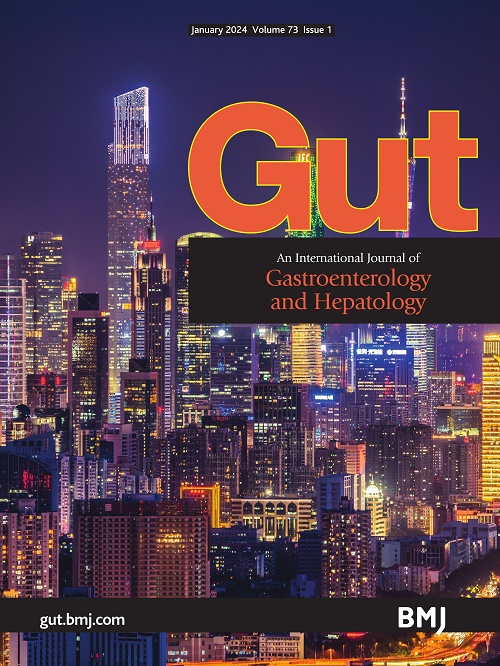Cholesterol’s new tricks propel MASH-HCC: impact in immunotherapy
IF 23
1区 医学
Q1 GASTROENTEROLOGY & HEPATOLOGY
引用次数: 0
Abstract
Hepatocellular carcinoma (HCC) is the most common type of liver cancer and the end-stage of chronic liver diseases, including metabolic-associated steatohepatitis (MASH), an advanced form of metabolic dysfunction-associated steatotic liver disease. The incidence of MASH-driven HCC is expected to continue rising throughout the world due to its association with the obesity and type 2 diabetes epidemic.1 HCC has a poor prognosis with frequent recurrence and intrahepatic metastasis and effective treatment options, such as local ablative therapies, resection or transplantation are mainly limited to early disease stages.1 Unfortunately, the therapeutic armamentarium for HCC is limited, ineffective and subject to secondary or acquired chemoresistance indicating the urgent need to understand the molecular mechanisms leading to MASH-HCC that will allow the identification of new therapeutic targets for the treatment of MASH-HCC development. Although targeting programmed death-ligand 1/programmed cell death protein-1 (PD-1) in the tumour immune microenvironment (TIME) with immune checkpoint inhibitors has shown promising results in different cancer types, the impact of this approach in HCC is somewhat less effective, particularly in MASH-driven HCC tumours which harbour a unique TIME with an accumulation of an exhausted T-cell subsets (CD8+ PD-1+) contributing to the refractory response to anti-PD-1 therapy.2 Since the description that the type rather than the amount of fat drives the transition from steatosis to MASH,3 cholesterol has emerged as a crucial player in MASH pathogenesis and MASH-driven HCC development in part through the generation of bile acids (BAs) via the alternative pathway in which mitochondrial cholesterol is metabolised to the oxysterol 27-hydroxycholesterol to fuel BAs synthesis.4 Previous studies demonstrated that de novo cholesterol synthesis in the mevalonate pathway propels MASH progression5 with a crucial role of squalene epoxidase (SLQE) in MASH-HCC development whose expression is associated with poor outcome in patients with MASH-HCC. …胆固醇的新技巧推动了 MASH-HCC:对免疫疗法的影响
肝细胞癌(HCC)是最常见的肝癌类型,也是慢性肝病(包括代谢相关性脂肪性肝炎(MASH),一种代谢功能障碍相关性脂肪性肝病的晚期形式)的终末阶段。1 HCC 的预后较差,经常复发和肝内转移,有效的治疗方案,如局部消融治疗、切除或移植,主要局限于疾病的早期阶段。遗憾的是,HCC 的治疗手段有限、效果不佳,而且会产生继发性或获得性化疗耐药性,这表明迫切需要了解导致 MASH-HCC 的分子机制,从而确定治疗 MASH-HCC 的新靶点。虽然以肿瘤免疫微环境(TIME)中的程序性死亡配体 1/程序性细胞死亡蛋白-1(PD-1)为靶点的免疫检查点抑制剂已在不同癌症类型中显示出良好的效果,但这种方法在 HCC 中的效果却稍逊一筹,尤其是在 MASH 驱动的 HCC 肿瘤中,这种肿瘤具有独特的 TIME,其中积聚的 T 细胞亚群(CD8+ PD-1+)耗竭导致了抗 PD-1 疗法的难治性反应。自脂肪的类型而非数量被描述为从脂肪变性到 MASH 的驱动因素3 后,胆固醇已成为 MASH 发病机制和 MASH 驱动的 HCC 发展中的关键因素,其部分作用是通过替代途径生成胆汁酸(BA),其中线粒体胆固醇被代谢为氧基甾醇 27-羟基胆固醇,以促进胆汁酸的合成4。以前的研究表明,甲羟戊酸途径中的新胆固醇合成推动了 MASH 的发展5,角鲨烯环氧化酶 (SLQE) 在 MASH-HCC 的发展中起着至关重要的作用,其表达与 MASH-HCC 患者的不良预后有关。...
本文章由计算机程序翻译,如有差异,请以英文原文为准。
求助全文
约1分钟内获得全文
求助全文
来源期刊

Gut
医学-胃肠肝病学
CiteScore
45.70
自引率
2.40%
发文量
284
审稿时长
1.5 months
期刊介绍:
Gut is a renowned international journal specializing in gastroenterology and hepatology, known for its high-quality clinical research covering the alimentary tract, liver, biliary tree, and pancreas. It offers authoritative and current coverage across all aspects of gastroenterology and hepatology, featuring articles on emerging disease mechanisms and innovative diagnostic and therapeutic approaches authored by leading experts.
As the flagship journal of BMJ's gastroenterology portfolio, Gut is accompanied by two companion journals: Frontline Gastroenterology, focusing on education and practice-oriented papers, and BMJ Open Gastroenterology for open access original research.
 求助内容:
求助内容: 应助结果提醒方式:
应助结果提醒方式:


